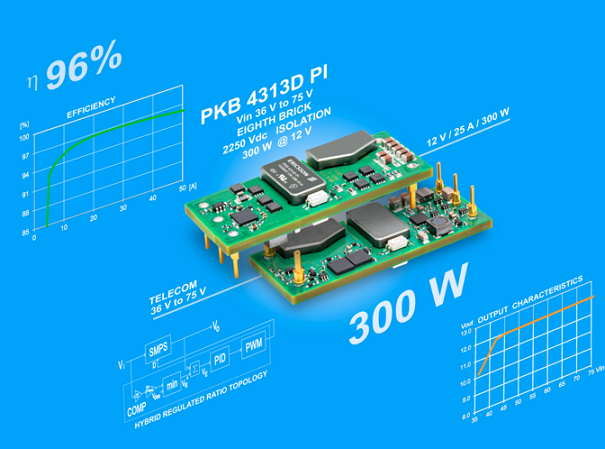
• Offering efficiencies of up to 96% at 12V output, the module significantly reduces energy and cooling costs
• PKB4313D's advanced design offers an excellent thermal-derating profile for challenging environments that have high ambient temperatures or limited airflow
• High-performance DC/DC converter delivers tightly regulated power for intermediate bus conversion applications in telecom and networking sectors
Ericsson announced the launch of a new low-profile 12V-output digital DC/DC converter module that offers up to 25A current handling and 300W of power to deliver tightly regulated voltages to point-of-load (POL) DC/DC regulators. Compatible with the DOSA (Distributed-power Open Standards Alliance) 5-pin eighth-brick footprint standard and offering an input range from 36V to 75V, the new PKB4313D advanced bus converter is ideal for intermediate bus conversion in ICT (Information and Communication Technologies) applications.
Offering excellent thermal capabilities, the new high-power module employs Ericsson's leading-edge HRR technology to deliver high-power conversion across a wide input voltage range, while keeping power losses low. Combined, all these factors have resulted in a module that delivers high-efficiency power conversion with exemplary performance in thermally challenging environments. Delivering a typical efficiency that exceeds 96% with a 48V input and 12V output at half-load, the module also offers significantly reduced energy and cooling costs. Competitive products will typically dissipate 15% or more power at full load than the PKB4313D.
The PKB4313D is the first product to be launched from Ericsson's new high-power PKB-D eighth-brick platform and will be followed by 3.3V and 5V output regulators, as well as additional 12V output modules that will offer different input voltage ranges and power levels. Meeting the requirements for deployment in distributed power and intermediate bus voltage architectures within the ICT, telecom and industrial sectors, the new module targets high-power and high-performance use in networking and telecommunications equipment, servers and data storage applications, as well as industrial equipment.
In developing this advanced DC/DC module, Ericsson has leveraged its highly innovative HRR topology. The technology was initially introduced in the company's high-end quarter-brick PKM-NH family, but has now been further enhanced to deliver even better utilization of the powertrain. The scheme operates with ratio-regulation in the very-low-input range with the ability to handle transients and sudden changes in input voltage, and it operates in normally regulated fixed-voltage mode from a 42V input and above. The module's excellent response to line and load transients guarantees the output voltage will remain stable and immune from voltage deviations that are due to power disturbances on the system bus. This retains intermediate bus voltage integrity within the tolerance band required by power system architects.
The module's powertrain also employs full-bridge synchronous rectification on the primary side, which is not commonly found in competitive devices in this price range. This combined with the use of latest-generation transistors (FETs) results in excellent efficiency across the entire power range. Use of the HRR control scheme has resulted in a reduction in overall power loss, below a 42V input, of up to 15%.
Delivering excellent thermal performance in challenging circumstances, the regulator provides higher useable power in high ambient temperatures or limited-airflow environments leading to higher reliability. For example, employment of tellurium copper pins provides excellent thermal transport. In addition, the FETs are placed on the module's topside, making it easy to attach a thermal gap pad directly to the FETs and transport heat to an optional baseplate to connect the module to a heat sink or cold plate. The module's optimized design using low-profile thermally critical components also achieves outstanding heat transfer to the baseplate or heat sink.
The PKB4313D comes in the industry-standard eighth-brick format, measuring 2.30 x 0.89 x 0.38 inches (58.4 x 22.7 x 9.6mm). The module is available in through-hole and surface-mount versions to provide high flexibility in board assembly. The module provides 2250V(dc) input/output (I/O) isolation and also incorporates a number of I/O protection and operational features. These include monotonic start-up and remote control as well as input-under-voltage shutdown, output over-voltage, over-temperature and output short-circuit protection. The device meets safety requirements according to IEC/EN/UL60950-1 and has a calculated MTBF of 8.9 million hours.
Martin Hägerdal, President, Ericsson Power Modules, says: “The new PKB4313D is the first in a new series of high-power advanced intermediate bus converters from Ericsson. The module combines the company's innovative HRR topology, which has been further enhanced for this new series, together with world-class power efficiency, tightly regulated voltage capabilities and best-in-class thermal handling characteristics. Overall, the new product offers a compelling package that delivers significant competitive advantage to customers operating at the cutting edge in a range of telecom, networking and industrial applications.”
The PKB4313D has been designed and manufactured by Ericsson to meet the highest standards available for DC/DC power converters in the industry, delivering the levels of quality and confidence that are required by power system designers to develop long-term and high-performance platforms.
The PKB4313D is priced at $30 in OEM quantities.
Download Datasheet here
Advertisement
Learn more about Ericsson Power Modules





